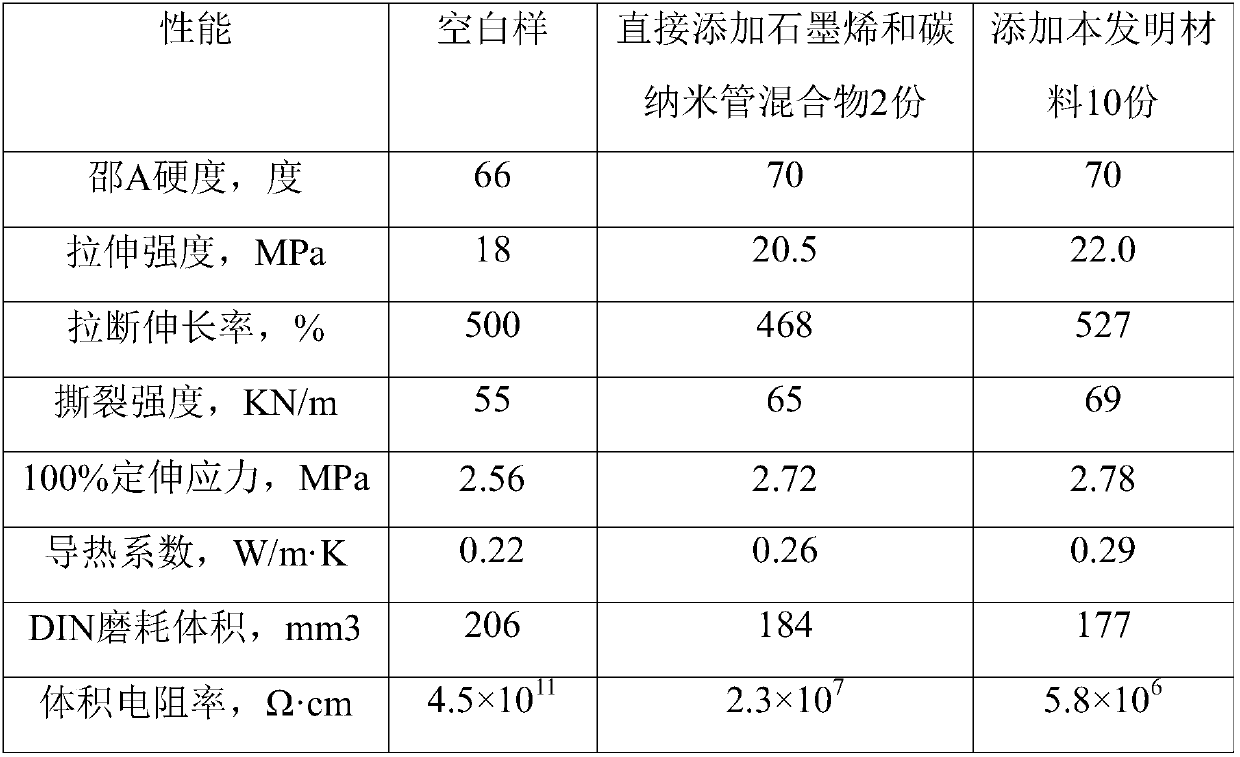Modified composite material using carbon nanotubes and graphene and preparation method thereof
A composite material and carbon nanotube technology, which is applied in the field of rubber products, can solve the problems of polymer material compatibility, volatility, insufficient durability, difficult to eliminate, and affect the appearance of products
- Summary
- Abstract
- Description
- Claims
- Application Information
AI Technical Summary
Problems solved by technology
Method used
Image
Examples
Embodiment 1
[0026] Embodiment 1 of the present invention provides a modified composite material using carbon nanotubes and graphene, wherein the rubber composite material includes the following raw materials in parts by weight: 2-5 parts of graphene, 10-20 parts of carbon nanotubes, liquid 3-8 parts of rubber, 3-6 parts of methacrylic acid, 3-6 parts of zinc oxide, 0.1-0.2 parts of peroxide initiator, 30-40 parts of thermoplastic elastomer, and 30-40 parts of softener.
[0027] Wherein, the thermoplastic elastomer includes at least one of thermoplastic styrene-butadiene rubber (SBS), polyvinyl chloride (PVC), ethylene vinyl acetate (EVA), polyurethane elastomer (TPU), and thermoplastic vulcanizate (TPV). The softening agent includes at least one of aromatic oil, naphthenic oil, paraffin oil, citric acid ester and polyester softening agent. The liquid rubber includes at least one of low molecular weight butadiene, isobutylene, isoprene, nitrile and ethylene propylene.
[0028] Exemplarily...
Embodiment 2
[0035] Add graphene, carbon nanotubes, and methacrylic acid into the speed-adjustable mixer at room temperature, and the mixing ratio is 4:16:4 by weight. Stir at high speed and mix evenly, then heat and react for 10 minutes; add zinc oxide at low speed and liquid butadiene rubber, high-speed stirring after adding the peroxide initiator in batches, wherein, the weight and number ratio of the added zinc oxide, liquid butadiene rubber and peroxide is 4:5.9:0.1; Add styrene butadiene elastomer and softener aromatic oil at 180°C, the weight ratio of styrene butadiene elastomer and softener aromatic oil is 30:36; cool the material after high temperature plasticization, The material of the present invention is obtained by granulating through a screw extruder.
[0036] The material prepared in Example 2 is compared with directly adding graphene and carbon nanotubes into the tire tread rubber filled with white carbon black. The comparison of the properties of the two rubbers is shown ...
Embodiment 3
[0040] Add graphene, carbon nanotubes, and methacrylic acid into a speed-adjustable mixer at room temperature, and the ratio of parts by weight is 4:16:3. Mix evenly with high-speed stirring and then heat and react for 10 minutes; add zinc oxide and liquid at low speed Butadiene rubber, add peroxide initiator in batches and stir at high speed, the ratio of parts by weight is 3:3.9:0.1; finally add styrene butadiene elastomer and softener aromatic oil when the temperature is 180°C, The ratio of parts by weight is 30:40; the material is cooled after being plasticized at high temperature, and granulated by a screw extruder to obtain the material of the present invention.
[0041] The material prepared in Example 3 was directly mixed into the SBS material for a comparative test. After adding 10 parts of the material of the present invention, the tensile strength of the SEBS material was increased from the original 15MPa to 18MPa, and the volume resistivity of the rubber material wa...
PUM
| Property | Measurement | Unit |
|---|---|---|
| tensile strength | aaaaa | aaaaa |
| electrical resistivity | aaaaa | aaaaa |
| tensile strength | aaaaa | aaaaa |
Abstract
Description
Claims
Application Information
 Login to View More
Login to View More - R&D
- Intellectual Property
- Life Sciences
- Materials
- Tech Scout
- Unparalleled Data Quality
- Higher Quality Content
- 60% Fewer Hallucinations
Browse by: Latest US Patents, China's latest patents, Technical Efficacy Thesaurus, Application Domain, Technology Topic, Popular Technical Reports.
© 2025 PatSnap. All rights reserved.Legal|Privacy policy|Modern Slavery Act Transparency Statement|Sitemap|About US| Contact US: help@patsnap.com



